Referencing the Gospels: Eusebius’s Canon Tables

Anyone who has read through the Gospels has had the strange feeling these four books are somehow both very similar, yet noticeably different. While modern scholars offer various explanations for the relationship between the Gospels, especially Matthew, Mark, and Luke, called the Synoptics, this close relationship has been obvious for at least as long as the four have been read together — some time in the second century.
Modern readers have plenty of reference materials to find where the Gospels tell the same, or similar, stories. Most Bibles today have cross-references right on the page, and commentaries and synopses are readily available. But what was an ancient reader to do if they wanted to do the same type of comparison? Not only were there far fewer resources, but the chapters and verses familiar today were not standardized until the sixteenth century. In fact, verses did not really exist at all before that.
Eusebius of Caesarea, a bishop, historian, and theologian who lived in the third and fourth centuries, however, devised a solution. In his letter to Carpianus, a fellow Christian, he explains how he, building on the work of Ammonius the Alexandrian, came up with a system to arrange the sections of the Gospels by whether a given story had parallels in other Gospels. He divided the Gospels into 10 sections, called canons, and used these as a reference system that could be easily consulted.
The first canon was for material appearing in all four Gospels. Canons 2–4 were for material appearing in a combination of three Gospels, such as a story found in all three Synoptics (like the healing of a leper in Matthew 8:1–4, Mark 1:40–45, and Luke 5:12–14), or a saying found in Matthew, Luke, and John, but not in Mark. Canons 5–9 were for material appearing in just two Gospels, like a saying in Matthew and Luke (e.g., the Beatitudes) or an event in Matthew and John. (For those keeping track, there are five instead of six canons in this category because no section is shared by only Mark and John, or by only Mark, Luke, and John.) The final canon was for sections unique to each Gospel. Eusebius then divided the Gospels into “pericopes,” more or less thematic paragraphs, and numbered each of them in order.

Figure 1: Canon 5 and the beginning of Canon 6 in Latin from a Gospel Book, ca. 11th century, MS.000607. © Museum of the Bible, 2021.
Now comes the genius of this system. Next to each pericope, a scribe would put both the canon number and the pericope number. Then, at the beginning of the manuscript, the 10 canons would be arranged in a table, often with artistic, architectural flourishes. The reader could then look up the pericope they were reading in the canon table indicated and find the numbers of the corresponding passages in the other Gospels. All this without chopping up the text or rearranging it to put the Gospels all in the same order.
These Eusebian canon tables spread throughout the Christian world and can be found in Gospel manuscripts across translations and regions. Even today, scholarly editions like the Nestle-Aland Greek New Testament come printed with the canon tables, canon numbers, and Eusebius’s letter explaining their use.
This set of canon tables from an Armenian manuscript is a wonderful example of the common features found in Gospel manuscripts.

Figure 2: Canon table from MS.000468.1. © Museum of the Bible, 2021.
You can see the architectural motif of an archway supported by pillars, which is found in most representations of the canons, and inside is the crucial piece: the grid containing the canon table. In Armenian discussions of this architectural frame, it is called a xoran, which, among other things, could mean “pavilion” or “tent,” rather than canon. On the outside of the archway, you find birds, which appear not only in Armenian presentations, but in many other versions of the canon tables, including Greek, Ethiopic, and Latin. Armenian authors, however, have a long tradition of commenting on the symbolic significance of the birds that belong on the canon tables, which is not found in other cultures. The chalice at the top of the arch is less common, though in many cases we find some decoration in this spot.[1]

Figure 3: Detail of the arches. © Museum of the Bible, 2021.
In the two small arches we are told which canon we are looking at, and in the first row of each column we are told the Gospels being compared. On this page, we are in canon 5, in which Matthew and Luke are compared. Sure enough, in the first row of each column we find the names “Matthew” and “Luke” repeated.

Figure 4: Detail of the first line. The yellow boxes identify the Gospel of Matthew; the green identifies the Gospel of Luke. © Museum of the Bible, 2021.
Following typical Armenian tradition, we have the entirety of canon 5, with the rest of the grid left blank. The table begins with pericopes 3 and 2 in Matthew and Luke respectively, as shown by their Armenian numerals, and ends in 272 and 231. This tells us the first place only Matthew and Luke agree is the birth of Jesus to Joseph and Mary, and the last is the punishment of figures at the end of certain parables.

Figure 5: Detail of Canon V. © Museum of the Bible, 2021.
On your next visit, make sure you find this Armenian example of Eusebius’s canon tables on the History of the Bible Floor.

